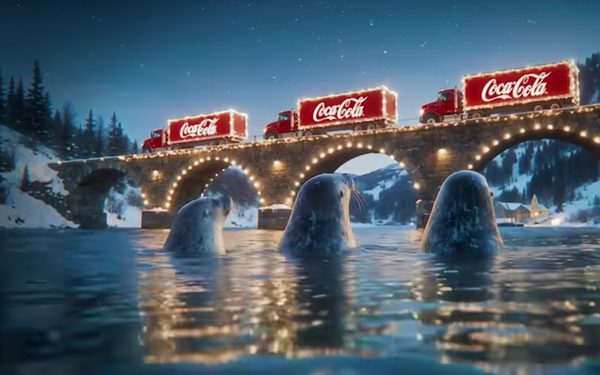
For the second consecutive year, Coca-Cola
experienced a backlash to its holiday ads made with generative AI.
The company claims to have made some changes following last year’s criticism. For one, this year’s spin on the brand’s classic 1995 “Holidays Are Coming” ad leans on animals, avoiding the AI depictions of people that
unsettled audiences in 2024.
But commenters online claim inconsistencies within the spot, such as varying depictions of the Coca-Cola trucks, show it doesn’t hold up to scrutiny as well
as the company’s claims of close human monitoring and quality control would suggest.
“Even sophisticated AI animations can appear cold or impersonal if they overshadow the story,
characters, or brand values that audiences expect,” Top Marketing Agency CEO Jeff Sherman told Marketing Daily. “Viewers reacted negatively because the ad lacked the warmth, subtle
cues, and playful imperfections that make the brand’s seasonal campaigns memorable.”
advertisement
advertisement
Some online commenters assumed Coca-Cola turned to AI solely to cut costs, heightening negative
brand perceptions around a lack of authenticity in its holiday advertising.
Coca-Cola didn’t disclose the cost of the campaign, made in partnership with WPP’s dedicated agency team
and the AI creative studios Silverside and Secret Level. But CMO Manolo Arroyo told the Wall Street Journal it was cheaper and faster to produce than previously, cutting the time required from
a year in advance to “around a month.”
“There’s little doubt that cost efficiency played a role in Coca-Cola’s AI campaign strategy, even if not the primary
one,” Sherman said.
“Traditional large-scale holiday productions, especially those involving international crews, animation, and music licensing, can easily exceed $1 million to $3
million per ad. Generative AI tools can reduce that by up to 60%–70%,” he said, citing WARC and Deloitte’s 2024 Global Marketing Tech Report. “That kind of efficiency is
appealing to every global brand.”
Did the brand need to create a new ad at all? How would the costs of the AI campaign compare to what it could accomplish by simply running its classic
1995 “Holidays Are Coming” ad, a preference expressed by some online commenters critical of the new ad?
“Rerunning the original 1995 ‘Holidays Are Coming’ ad,
which was one of the most beloved in advertising history, would absolutely have delivered nostalgia at a fraction of the cost,” Sherman said. “But the drawback is stagnation. Brands of
Coca-Cola’s scale can’t simply recycle heritage indefinitely.”
Vanessa Chin, senior vice president of marketing at System1, a marketing platform that tests the creative
effectiveness of ads, disagreed. Chin told Marketing Daily Coca-Cola could have leaned on the original campaign to connect with consumers “without the backlash tied to AI-generated
content.”
“System1’s research suggests that strong creative assets typically ‘wear in’ over time, building mental availability and improving both short- and
long-term performance,” she said. “A nostalgic ad like the 1995 version would likely have benefited from this effect, especially as older audiences associate it with positive
memories.”
She added, “AI-driven campaigns, though currently novel, tap into cultural conversations and signal innovation, which can be important for brand perception. The
challenge is that novelty wears out quickly.”
One example: Google Gemini’s “Dear Sydney’ declined from a rating of 4.4 (out of 6) stars last year to 3.7 in System
1’s analysis. “This suggests that AI’s initial appeal fades faster than traditional creative assets. In Coca-Cola’s case, repeated use of AI could amplify skepticism,
especially as consumers become more aware of its prevalence.”
Social media can also shape perceptions and create a feedback loop amplifying negative sentiment.
“Consumer
perception can absolutely be influenced by news coverage or negative social commentary,” Chin said. Media and online discourse act as framing devices that shape how people interpret creative
work after the fact. If the narrative becomes ‘AI ads are inauthentic,’ some viewers may approach the ad with skepticism.”
“Even if only a small, vocal minority reacts
negatively, the algorithmic amplification on social media can distort sentiment,” Sherman added. “The reputational risk is real, particularly for brands without Coca-Cola’s deep well
of goodwill and nostalgia. A smaller or newer brand pulling the same move could face lasting damage.”